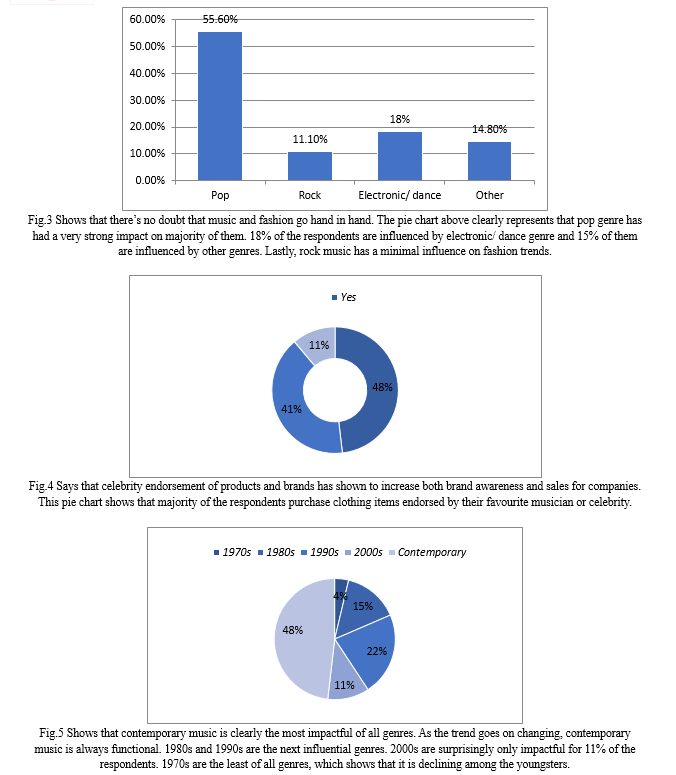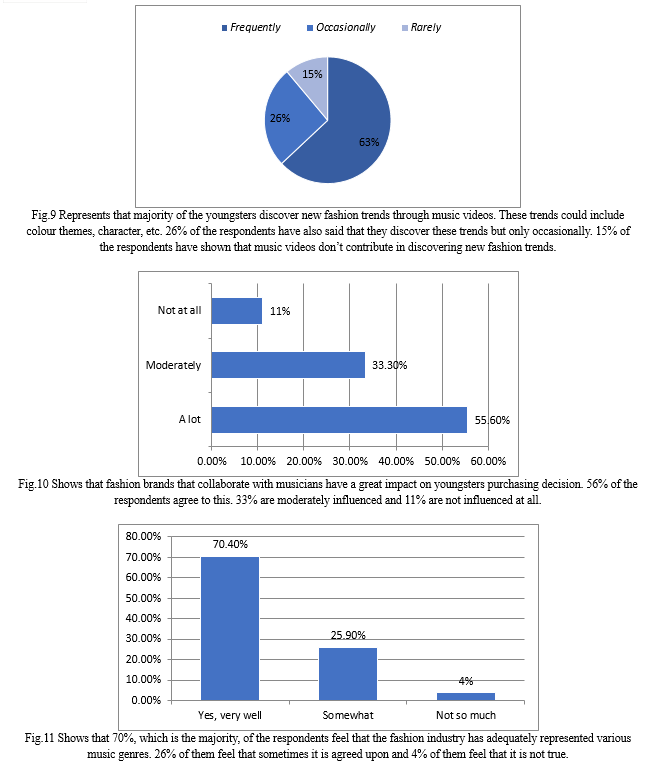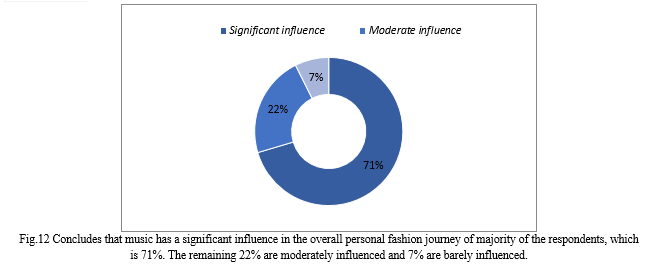Ijraset Journal For Research in Applied Science and Engineering Technology
- Home / Ijraset
- On This Page
- Abstract
- Introduction
- Conclusion
- References
- Copyright
The Influence of Music Genres on Fashion Styles; a Cross-Culture Analysis on Youngsters
Authors: Harshika R, Shashi Nag
DOI Link: https://doi.org/10.22214/ijraset.2024.58337
Certificate: View Certificate
Abstract
This study roots into the complex relationship between music and fashion, aiming to reveal the significant impact of music on the continually changing fashion industry. It has long been acknowledged that music, as a potent cultural force, can influence social conventions, feelings, and manifestations. In a similar vein, fashion conveys identity, culture, and inventiveness through its visual language. This research attempts to clarify the mutually beneficial link between these two artistic mediums by investigating the ways in which music both actively influences and reflects fashion trends over time. The study takes an interdisciplinary approach, tracing the dynamic relationships between music and fashion through historical investigations, cultural studies, and sociological viewpoints. We examine how genres and subcultures make a lasting impression on fashion choices through case studies that range from the rebellious styles of the 1950s rock \'n\' roll era to the avant-garde fusions of modern pop and hip-hop influences. The study looks at how celebrities, from present influencers like Rihanna to historical icons like Elvis Presley, become fashion trendsetters and change agents. The research also explores the psychological and emotional aspects of this link, looking at how design decisions, colour schemes, and even the general public\'s definition of beauty are influenced by the beat, lyrics, and spirit of music. The goal of the paper is to present a thorough understanding of the mutual effect between music and fashion, illuminating the processes by which cultural change is manifested visually. In summary, this study adds to the expanding literature of research examining the relationship between fashion and music, providing insights into the processes that influence fashion and stimulate innovation. Comprehending this mutually beneficial association enhances our admiration for both artistic mediums and also presents opportunities for interdisciplinary cooperation, thereby moulding the cultural terrain of the times.
Introduction
I. INTRODUCTION
Music has always been a driving force behind the growth of fashion, impacting not just what people wear but also how they view the world and themselves. For example, the mid-20th century rock 'n' roll explosion introduced a rebellious spirit that inspired iconic hairstyles, skinny jeans, and leather jackets.
Fashion changed along with the genres, adjusting to the varied sounds and societal changes. The disco era of the 1970s gave rise to flamboyant and dazzling looks, which were emulated by celebrities such as David Bowie, whose audacious and gender-bending wardrobe selections connected with a newly discovered feeling of uniqueness. As hip-hop gained popularity in the 1980s and 1990s, it sparked a revolution in streetwear, with distinctive accessories, large apparel, and sneakers coming to be associated with the genre. Performers such as Run-DMC not only influenced a generation's sound, but also established its fashion sense.
Pop music has always been a major influence on fashion trends because of its widespread appeal. In addition to dominating the charts, fashion icons like Madonna, Michael Jackson, and Beyoncé have left a lasting impression on millions of people with their unique looks and boundary-pushing designs.
The relationship between music and fashion has grown increasingly complex in the digital age, as social media has increased the influence of both sectors. The increasing number of music festivals serving as fashion shows and the partnerships between musicians and fashion labels highlight the mutual influence between these two artistic disciplines.
Essentially, music's impact on fashion is a continuous story, a melodic conversation that shapes our wardrobe preferences and cultural aesthetics, demonstrating the significant influence of rhythm and melody on the ever changing canvas of style.
II. OBJECTIVES
- Examine Sub cultural Movements: Explore the mutually beneficial link between music and sub cultural movements, exploring the ways in which particular genres have influenced the development of personal expression and given rise to distinctive fashion subcultures.
- Comprehend Iconic Collaborations: Examine prominent partnerships between fashion designers and artists, analyzing the effects these alliances have had on the two fields and how they have influenced the current state of the fashion industry.
- Assess Social and Cultural Impacts: Explore how music's influence on fashion extends beyond aesthetics, impacting society standards, identity expression, and cultural perspectives. Examine the ways in which particular styles have been embraced as expressions of solidarity, joy, or protest.
- Analyze Digital Era Dynamics: Look into how social media and digital platforms contribute to the growing relationship between music and fashion. Examine how the internet has made it easier for people to collaborate, share trends, and blur traditional boundaries.
- Examine Global Influences: Examine how music transcends cultural boundaries and how a variety of global musical genres have influenced a global fusion of styles that have broken down barriers to fashion.
- Examine Gender and Identity Expressions: Examine how music has influenced gender norms and expressions in fashion, from the androgynous styles of rock to the gender-blurring fashion statements of contemporary pop and hip-hop artists.
- Evaluate Economic Impacts: Evaluate the economic implications of music's influence on fashion, taking into account the commercial success of artist-endorsed clothing lines, merchandising, and the overall market dynamics shaped by these collaborations.
- Analyze Current Trends: Examine how artists today continue to shape and redefine style. Gain an understanding of the current landscape and anticipate potential future intersections between music and fashion.
- Think Sustainability: Examine how music might encourage ethical and sustainable fashion practices. Examine the programs and efforts that the music industry has launched to encourage environmentally friendly choices in apparel and accessories.
III. REVIEW OF LITERATURE
The dynamic connection between music and fashion holds significant sway among young individuals, transcending mere aesthetics to become a profound expression of cultural influence. This intricate relationship reflects the evolving nature of youth culture, where the synergy between musical preferences and fashion choices creates a vibrant tapestry of self-expression. It's crucial to recognize that music and fashion are not isolated elements but rather intertwined aspects of identity. Youngsters often draw inspiration for their style from the music they resonate with, turning their clothing selections into visual representations of their musical affiliations. This interplay is reciprocal; just as music inspires fashion, fashion becomes a visual language that enhances and complements the auditory narratives of various musical genres. Scholars like Bennett (2000) [1] and Frith (1981) [2] have explored how music serves as a tool for identity construction, offering individuals a sense of belonging to specific subcultures. This sense of belonging often extends to fashion choices, with individuals adopting styles associated with the music genres that resonate with their identity. Examining the late 1970s punk movement provides a notable case study. Hebdige's (1979) [3] influential work on subcultures underscores how the rebellious ethos of punk music manifested in the fashion choices of its adherents. The do-it-yourself (DIY) aesthetic, ripped clothing, and unconventional hairstyles became synonymous with punk subculture, illustrating how music can act as a catalyst for distinct and influential fashion movements.
In the digital era, the internet has significantly magnified the link between music and fashion. Social media platforms like Instagram and TikTok now serve as potent tools for musicians and influencers to showcase their personal style. Furthermore, the role of music videos in shaping fashion trends is emphasized by studies conducted by Green and Jenkins (2013) [4]. Iconic music videos often serve as visual spectacles that shape viewers' perceptions of style. For example, Michael Jackson's "Thriller" not only left an enduring mark on the music industry but also became a cultural touchstone for 1980s fashion, with Jackson's red leather jacket becoming an iconic piece. The influence of music festivals on fashion trends is another intriguing area of exploration. Scholars such as Bennett and Kahn-Harris (2004) [5] have scrutinized how festivals, like Coachella, have evolved into fashion showcases, with attendees curating outfits that mirror the ethos of the performing musical acts. The intersection of music and fashion at these events provides a unique space for youthful experimentation and expression. Recognizing celebrity musicians as influential figures in fashion is essential. Research by Simmel (1904) [6] on fashion and distinction remains relevant today, as musicians like Rihanna, Kanye West, and Billie Eilish leverage their status to redefine fashion norms. Collaborations with established fashion houses and the launch of personal fashion lines underscore the dynamic relationship between the music and fashion industries.
Nevertheless, it is crucial to consider the potential downsides of this convergence. Critics argue that the commodification of music and fashion may lead to inauthentic expressions of identity. Thornton (1995) [7] discusses the commercialization of sub cultural styles, suggesting that it could dilute the rebellious and authentic nature of fashion movements driven by youth culture. The influence of music on fashion extends to collaborative efforts between musicians and fashion brands. Artists frequently venture into the design realm, creating limited-edition collections or collaborating with established brands to merge their musical persona with the visual language of fashion. These collaborations not only offer fans tangible connections to their favourite artists but also underscore the enduring interplay between music and style.
IV. METHODS AND METHODOLOGY
This study is based on the complex relationship between music and fashion, aiming to reveal the significant impact of music on the continually changing fashion industry. Google forms were sent out in order to conduct a survey to analyse this relationship as primary research. There were 27 respondents. Since the aim of this study focuses on youngsters, the age group 18 – 25 was targeted. As part of the secondary research, journals, newspapers and websites were sourced.





VI. ACKNOWLEDGEMENT
I would like to convey my heartfelt gratitude to our Principal, Dr. N. Jothilakshmy for her tremendous support and assistance in the completion of my project. Her support and guidance in completing our project on the topic (The influence of music genres on fashion styles; a cross-culture analysis on youngsters) was of great learning experience. I would also like to take this opportunity to express my gratitude to my Professor Dr. Shashi Nag. The project would not have been successful without her cooperation and inputs.
Conclusion
It\'s essential to acknowledge that the relationship between music and fashion is not unidirectional. Fashion, too, plays a pivotal role in shaping the musical narrative. Iconic artists are often remembered not only for their sonic contributions but also for their distinctive fashion choices. From David Bowie\'s eclectic glam-rock ensembles to Lady Gaga\'s avant-garde couture, fashion becomes an integral part of the artistic persona. In summary, the influence of music in fashion among youngsters is a nuanced and ever-evolving phenomenon. It transcends the surface-level correlation of clothing and musical genres, rooting into the realms of identity, self-expression, and the symbiotic relationship between auditory and visual storytelling. As the cultural landscape continues to evolve, so will the dynamic interplay between music and fashion, weaving a tapestry that mirrors the diverse and ever-changing nature of youth culture.
References
[1] Bennett, Andy. 2000. Popular music and youth culture: Music, identity and place. Macmillan publishers. [2] Frith, Simon. 1981. The industrialisation of popular music. Condor Depaul University publishing. [3] Hebdige, Dick. 1979. The function of subculture. New York: Routledge, 1999. 441-50. [4] Green, Joshua; Jenkins, Henry; Ford, Sam. 2013. Spreadable Media: creating value and meaning in a networked culture. New York University press. [5] Kahn-Harris, Keith. 2004. The ‘Failure’ of Youth Culture: Reflexivity, Music and Politics in the Black Metal Scene. European Journal of Cultural Studies. [6] Simmel, Georg. 1904. Fashion. Journal of artificial societies and social simulation. [7] Thornton, Sarah. 1995. Club cultures: Music, media and, subcultural capital. Middletown, CT: Wesleyan University press.
Copyright
Copyright © 2024 Harshika R, Shashi Nag. This is an open access article distributed under the Creative Commons Attribution License, which permits unrestricted use, distribution, and reproduction in any medium, provided the original work is properly cited.

Download Paper
Paper Id : IJRASET58337
Publish Date : 2024-02-07
ISSN : 2321-9653
Publisher Name : IJRASET
DOI Link : Click Here
 Submit Paper Online
Submit Paper Online

